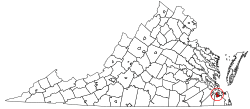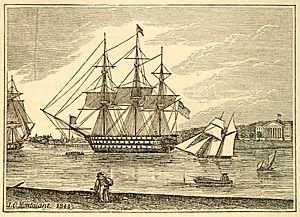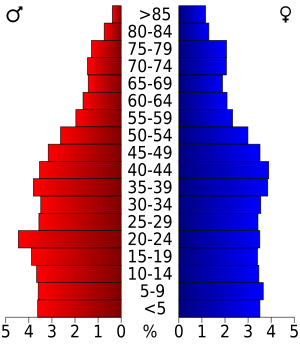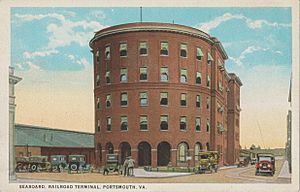Portsmouth, Virginia facts for kids
Quick facts for kids
Portsmouth, Virginia
|
||
|---|---|---|

Downtown Portsmouth on the Elizabeth River
|
||
|
||

Location in the Commonwealth of Virginia
|
||
| Country | ||
| State | ||
| Founded | 1752 | |
| Government | ||
| • Type | Council–manager | |
| Area | ||
| • Total | 46.68 sq mi (120.91 km2) | |
| • Land | 33.30 sq mi (86.25 km2) | |
| • Water | 13.38 sq mi (34.66 km2) | |
| Elevation | 20 ft (6 m) | |
| Population
(2020)
|
||
| • Total | 97,915 | |
| • Density | 2,940.39/sq mi (1,135.29/km2) | |
| Time zone | UTC−5 (EST) | |
| • Summer (DST) | UTC−4 (EDT) | |
| ZIP Codes |
23701-23709
|
|
| Area code(s) | 757, 948 (planned) | |
| FIPS code | 51-64000 | |
| GNIS feature ID | 1497102 | |
| Website | http://www.portsmouthva.gov/ | |
Portsmouth is an independent city in Virginia southwest and across the Elizabeth River from Norfolk. As of the 2020 census, the population was 97,915. It is part of the Hampton Roads metropolitan area.
The Norfolk Naval Shipyard and Naval Medical Center Portsmouth are historic and active U.S. Navy facilities located in Portsmouth.
Contents
History
Portsmouth is located on the western side of the Elizabeth River directly across from the City of Norfolk. In 1620, the future site of Portsmouth was recognized as suitable shipbuilding location by John Wood, a shipbuilder, who petitioned King James I of England for a land grant. The surrounding area was soon settled as a plantation community.
Portsmouth was founded by Colonel William Crawford, a member of the Virginia House of Burgesses. It was established as a town in 1752 by an act of the Virginia General Assembly and was named for Portsmouth, England.
In 1767, Andrew Sprowle, a shipbuilder, founded the Gosport Shipyard adjacent to Portsmouth. The Gosport Shipyard at Portsmouth was owned by the Commonwealth of Virginia after the American Revolutionary War and was sold to the new United States federal government.
In 1855, the Portsmouth and Norfolk area suffered an epidemic of yellow fever which killed 1 of every three citizens. It became an independent city from Norfolk County in 1858.
During the American Civil War, in 1861, Virginia joined the Confederate States of America. Fearing that the Confederacy would take control of the shipyard at Portsmouth, the shipyard commander ordered the burning of the shipyard. The Confederate forces did in fact take over the shipyard, and did so without armed conflict through an elaborate ruse orchestrated by civilian railroad builder William Mahone (soon to become a famous Confederate officer). The Union forces withdrew to Fort Monroe across Hampton Roads, which was the only land in the area which remained under Union control.
In early 1862, the Confederate ironclad warship CSS Virginia was rebuilt using the burned-out hulk of USS Merrimack. Virginia engaged the Union ironclad USS Monitor in the famous Battle of Hampton Roads during the Union blockade of Hampton Roads. The Confederates burned the shipyard again when they left in May 1862.
Following the recapture of Norfolk and Portsmouth by the Union forces, the name of the shipyard was changed to Norfolk Naval Shipyard. The name of the shipyard was derived from its location in Norfolk County. The Norfolk Naval Shipyard today is located entirely within the city limits of Portsmouth, Virginia. The Norfolk Naval Shipyard name has been retained to minimize any confusion with the Portsmouth Naval Shipyard, which itself is actually located in Kittery, Maine, across the Piscataqua River from Portsmouth, New Hampshire.
Portsmouth was the county seat of Norfolk County until 1963 when the new city of Chesapeake was formed in a political consolidation with the city of South Norfolk. Portsmouth's other county neighbor, the former Nansemond County, also consolidated with a smaller city, forming the new city of Suffolk in 1974.
One of the older cities of Hampton Roads, in the early 21st century, Portsmouth was undergoing moderate urban renewal in the downtown.
The APM "MAERSK" marine terminal for container ships opened in 2007 in the West Norfolk section.
Historic sites
Olde Towne
The Olde Towne Historic District features one of the largest collections of historically significant homes between Alexandria, Virginia and Charleston, South Carolina. The Emanuel African Methodist Episcopal Church was built by slaves and free men and is the second-oldest building in Portsmouth and the city's oldest black church.
The city contains a number of other historic buildings, as well, including the Pass House, which was built in 1841 by Judge James Murdaugh and occupied by Union troops from 1862 to 1865. Federal forces required Portsmouth residents to obtain a written pass to travel across the Elizabeth River and beyond. These passes were issued from the English basement and thus the name "Pass House" was derived.
Formerly the Naval Hospital Portsmouth, the Naval Medical Center Portsmouth is a United States Navy medical center adjacent to the Olde Towne Historic District and Park View Historic District. Founded in 1827, it is the oldest continuously running hospital in the Navy medical system with the motto "First and Finest."
Seaboard Coastline Building
Located at 1 High Street in the Olde Towne Historic District, the Seaboard Coastline Building is a historic train station and former headquarters of the Seaboard Air Line railroad company.
The Hill House
Four-story 1825 English basement home furnished entirely with original family belongings. It is evident from the furnishings that the Hill family were avid collectors and lived graciously over a period of 150 years. The house remains in its original condition, with limited renovation through the years.
Cedar Grove Cemetery
Established in 1832, Cedar Grove Cemetery is the oldest city-owned cemetery in Portsmouth. Listed on the National Register of Historic Places listings in Portsmouth, Virginia, the cemetery is noted for its funerary art and the civic, business, maritime, religious and military leaders who are buried there. Historical markers placed throughout the cemetery allow for self-guided tours. The cemetery is located between Effingham Street and Fort Lane in Olde Towne Portsmouth. Entrance is through the south gate to the cemetery, located on London Boulevard.
Geography

According to the United States Census Bureau, the city has a total area of 47 square miles (120 km2), of which 34 square miles (88 km2) is land and 13 square miles (34 km2) (28.0%) is water.
Climate
Portsmouth's mild humid subtropical climate means outdoor activities can be enjoyed year round. The weather in Portsmouth is temperate and seasonal. Summers are hot and humid with warm evenings. The mean annual temperature is 65 °F (18 °C), with an average annual snowfall of 3 inches and an average annual rainfall of 47 inches. No measurable snow fell in 1999. The wettest seasons are the spring and summer, although rainfall is fairly constant all year round. The highest recorded temperature was 105.0 °F in 1980. The lowest recorded temperature was -3.0 °F on January 21, 1985.
Additionally, the geographic location of the city, with respect to the principal storm tracks, is especially favorable, as it is south of the average path of storms originating in the higher latitudes, and north of the usual tracks of hurricanes and other major tropical storms. Snow falls rarely, averaging 3 inches (76 mm) per season.
| Climate data for Norfolk International Airport, Virginia (1981–2010 normals, extremes 1874–present ) | |||||||||||||
|---|---|---|---|---|---|---|---|---|---|---|---|---|---|
| Month | Jan | Feb | Mar | Apr | May | Jun | Jul | Aug | Sep | Oct | Nov | Dec | Year |
| Record high °F (°C) | 84 (29) |
82 (28) |
92 (33) |
97 (36) |
100 (38) |
102 (39) |
105 (41) |
105 (41) |
100 (38) |
95 (35) |
86 (30) |
82 (28) |
105 (41) |
| Mean maximum °F (°C) | 71.1 (21.7) |
73.2 (22.9) |
80.2 (26.8) |
86.4 (30.2) |
91.4 (33.0) |
95.5 (35.3) |
97.8 (36.6) |
95.8 (35.4) |
92.1 (33.4) |
85.6 (29.8) |
78.7 (25.9) |
72.5 (22.5) |
98.8 (37.1) |
| Average high °F (°C) | 48.1 (8.9) |
50.9 (10.5) |
58.2 (14.6) |
67.6 (19.8) |
75.4 (24.1) |
83.5 (28.6) |
87.4 (30.8) |
85.1 (29.5) |
79.3 (26.3) |
70.1 (21.2) |
61.1 (16.2) |
52.1 (11.2) |
68.3 (20.2) |
| Average low °F (°C) | 32.7 (0.4) |
34.4 (1.3) |
40.5 (4.7) |
48.9 (9.4) |
57.9 (14.4) |
67.1 (19.5) |
71.9 (22.2) |
70.7 (21.5) |
65.3 (18.5) |
54.0 (12.2) |
44.6 (7.0) |
36.1 (2.3) |
52.1 (11.2) |
| Mean minimum °F (°C) | 17.6 (−8.0) |
21.2 (−6.0) |
27.2 (−2.7) |
35.7 (2.1) |
45.7 (7.6) |
55.5 (13.1) |
63.1 (17.3) |
61.6 (16.4) |
53.7 (12.1) |
39.7 (4.3) |
30.5 (−0.8) |
21.7 (−5.7) |
15.2 (−9.3) |
| Record low °F (°C) | −3 (−19) |
2 (−17) |
14 (−10) |
23 (−5) |
36 (2) |
45 (7) |
54 (12) |
49 (9) |
40 (4) |
27 (−3) |
17 (−8) |
5 (−15) |
−3 (−19) |
| Average precipitation inches (mm) | 3.40 (86) |
3.12 (79) |
3.68 (93) |
3.41 (87) |
3.41 (87) |
4.26 (108) |
5.14 (131) |
5.52 (140) |
4.76 (121) |
3.42 (87) |
3.15 (80) |
3.26 (83) |
46.53 (1,182) |
| Average snowfall inches (cm) | 2.4 (6.1) |
2.0 (5.1) |
0.2 (0.51) |
trace | 0 (0) |
0 (0) |
0 (0) |
0 (0) |
0 (0) |
0 (0) |
trace | 1.2 (3.0) |
5.8 (15) |
| Average precipitation days (≥ 0.01 in) | 10.4 | 9.5 | 10.6 | 10.1 | 10.6 | 9.9 | 11.1 | 10.1 | 8.8 | 7.6 | 8.5 | 9.8 | 117.0 |
| Average snowy days (≥ 0.1 in) | 1.6 | 1.3 | 0.4 | 0.1 | 0 | 0 | 0 | 0 | 0 | 0 | 0 | 0.6 | 4.0 |
| Average relative humidity (%) | 66.3 | 65.6 | 64.6 | 62.8 | 68.8 | 70.6 | 73.3 | 75.2 | 74.4 | 72.1 | 68.5 | 67.0 | 69.1 |
| Mean monthly sunshine hours | 171.5 | 175.2 | 229.3 | 252.8 | 271.7 | 280.1 | 278.3 | 260.4 | 231.4 | 208.3 | 175.7 | 160.4 | 2,695.1 |
| Percent possible sunshine | 56 | 58 | 62 | 64 | 62 | 64 | 62 | 62 | 62 | 60 | 57 | 53 | 61 |
| Source: NOAA (relative humidity and sun 1961–1990) | |||||||||||||
Demographics
| Historical population | |||
|---|---|---|---|
| Census | Pop. | %± | |
| 1840 | 6,477 | — | |
| 1850 | 8,626 | 33.2% | |
| 1860 | 9,496 | 10.1% | |
| 1870 | 10,590 | 11.5% | |
| 1880 | 11,390 | 7.6% | |
| 1890 | 13,268 | 16.5% | |
| 1900 | 17,427 | 31.3% | |
| 1910 | 33,190 | 90.5% | |
| 1920 | 54,387 | 63.9% | |
| 1930 | 45,704 | −16.0% | |
| 1940 | 50,745 | 11.0% | |
| 1950 | 80,039 | 57.7% | |
| 1960 | 114,773 | 43.4% | |
| 1970 | 110,963 | −3.3% | |
| 1980 | 104,577 | −5.8% | |
| 1990 | 103,910 | −0.6% | |
| 2000 | 100,565 | −3.2% | |
| 2010 | 95,535 | −5.0% | |
| 2020 | 97,915 | 2.5% | |
| U.S. Decennial Census 1790-1960 1900-1990 1990-2000 2010-2013 |
|||
2020 census
| Race / Ethnicity | Pop 2010 | Pop 2020 | % 2010 | % 2020 |
|---|---|---|---|---|
| White alone (NH) | 38,526 | 34,912 | 40.33% | 35.66% |
| Black or African American alone (NH) | 50,327 | 51,586 | 52.68% | 52.68% |
| Native American or Alaska Native alone (NH) | 379 | 355 | 0.40% | 0.36% |
| Asian alone (NH) | 994 | 1,244 | 1.04% | 1.27% |
| Pacific Islander alone (NH) | 104 | 134 | 0.11% | 0.14% |
| Some Other Race alone (NH) | 118 | 490 | 0.12% | 0.50% |
| Mixed Race/Multi-Racial (NH) | 2,168 | 4,781 | 2.27% | 4.88% |
| Hispanic or Latino (any race) | 2,919 | 4,413 | 3.06% | 4.51% |
| Total | 95,535 | 97,915 | 100.00% | 100.00% |
Note: the US Census treats Hispanic/Latino as an ethnic category. This table excludes Latinos from the racial categories and assigns them to a separate category. Hispanics/Latinos can be of any race.
2010 Census
As of the 2010 census, there were 95,535 people, 38,170 households, and 25,497 families residing in the city. The population density was 3,032.7 people per square mile (1,170.9/km2). There were 41,605 housing units at an average density of 1,254.7 per square mile (484.4/km2). The racial makeup of the city was 53.3% African American, 41.6% White, 0.4% Native American, 1.1% Asian, 0.1% Pacific Islander, 1.0% from other races, and 2.6% from two or more races. Hispanic or Latino of any race were 3.1% of the population.
There were 38,170 households, out of which 30.6% had children under the age of 18 living with them, 41.1% were married couples living together, 10.9% have a female household with no husband present and 33.2% were non-families. 27.5% of all households were made up of individuals, and 10.8% had someone living alone who was 65 years of age or older. The average household size was 2.51 and the average family size was 3.05.
In the city, the population was spread out, with 25.7% under the age of 18, 11.1% from 18 to 24, 29.1% from 25 to 44, 20.3% from 45 to 64, and 13.8% who were 65 years of age or older. The median age was 34 years. For every 100 females, there were 93.5 males. For every 100 females age 18 and over, there were 90.6 males.
The median income for a household in the city was $46,340, and the median income for a family was $53,769. Males had a median income of $39,871 versus $33,140 for females. The per capita income for the city was $23,108. About 13.5% of families and 16.7% of the population were below the poverty line, including 27.1% of those under age 18 and 10.8% of those age 65 or over.
Arts and culture
Tourism
Portsmouth has a long history as a port town and city. The Olde Towne Business and Historical District is located in the downtown area, where a combination of preservation and redevelopment has been underway. An example is Hawthorn Hotel & Suites at The Governor Dinwiddie Hotel, which was renovated and reopened in 2005 after being closed for more than 10 years. It has been recognized by Historic Hotels of America, a program of the National Trust for Historical Preservation that identifies hotels that have maintained their historical integrity, architecture and ambiance and provides resources for their preservation. (Dinwiddie County near Petersburg was also named for him).
Other points of interest include the Portsmouth City Park, featuring the 2 ft (610 mm) narrow gauge Portsmouth City Railroad with an operating Chance Rides C.P. Huntington locomotive named Pokey Smokey II. The original Pokey Smokey locomotive was built by Crown Metal Products and ran at the park for many years before being sold at auction. It now runs on the Mideast Railroad in Ederville in Carthage, North Carolina.
Sister cities
 Portsmouth, United Kingdom
Portsmouth, United Kingdom Dunedin, New Zealand
Dunedin, New Zealand Orizaba, Mexico
Orizaba, Mexico Eldoret, Kenya
Eldoret, Kenya Goree Island, Senegal
Goree Island, Senegal
Sports
The Portsmouth Cavaliers were a basketball team founded in 2010 and played in the American Basketball Association for the 2011–12 season. Based in Portsmouth, Virginia, the Cavaliers played their home games at the Chick-fil-A Fieldhouse on the campus of Portsmouth Catholic Regional School. The club spent one season in the American Professional Basketball League (APBL) before folding.
Each April since 1953, the city hosts the Portsmouth Invitational Tournament, where college basketball seniors play in front of scouts from the NBA and top European leagues. Many top basketball stars played in the PIT before successful pro careers, including Jimmy Butler, Scottie Pippin, Dennis Rodman, and John Stockton.
Education
Primary and secondary schools
Portsmouth Public Schools operates public schools. There are three public high schools in Portsmouth, Virginia, located at three corners of the city. In the northwest section of the city, off Cedar Lane, is Churchland High School. In the downtown section of the city, between London Blvd and High Street, is I.C. Norcom High School. In the southwest section of Portsmouth, on Elmhurst Lane, is Manor High School.
Higher education
There are a number of institutions of higher education in and in close proximity to Portsmouth. The city is home to the Tri-Cities Higher Education Center of Old Dominion University (ODU), a public research university founded in 1930 whose main campus is located in Norfolk, Virginia. Portsmouth is also home to the Fred W. Beazley Portsmouth Campus of Tidewater Community College, a two-year higher education institution founded in 1968 in South Hampton Roads with additional campuses located in Chesapeake, Norfolk, and Virginia Beach. Angelos Bible College was established in 1984.
Infrastructure
Transportation
From the earliest development, Portsmouth has been oriented to the water. In the 1830s, it was the first community in Hampton Roads to receive a new land transportation innovation, railroad service. The Portsmouth and Roanoke Railroad, a predecessor of the Seaboard Air Line Railroad, extended to the rapids of the Roanoke River on its fall line near Weldon, North Carolina. It was to be 20 more years before its bigger neighbor, the city of Norfolk, also received a rail line, in 1858, when the Norfolk and Petersburg Railroad was completed. The Atlantic Coast Line Railroad operated passenger trains #36 and #5 to and from its North Portsmouth Station to Rocky Mount, North Carolina until 1954. In earlier years ACL ran trains including the Tar Heel all the way south to Wilmington, North Carolina.
From Seaboard Terminal the Seaboard Air Line and then the Seaboard Coast Line Railroad operated #17 and #18 to and from Raleigh, North Carolina, where the train joined with those companies' Silver Comet. The SAL also operated a local all-coach train (#3-11 southbound/#6-10 northbound) to Atlanta from the terminal. The 17/18 trains ended in 1968.
Portsmouth is primarily served by the Norfolk International Airport (IATA: ORF, ICAO: KORF, FAA LID: ORF), now the region's major commercial airport. The airport is located near Chesapeake Bay, along the city limits of neighboring Norfolk and Virginia Beach. Seven airlines provide nonstop services to twenty-five destinations. ORF had 3,703,664 passengers take off or land at its facility and 68,778,934 pounds of cargo were processed through its facilities. Newport News/Williamsburg International Airport (IATA: PHF, ICAO: KPHF, FAA LID: PHF) also provides commercial air service for the Hampton Roads area. The Chesapeake Regional Airport provides general aviation services and is located five miles (8 km) outside the city limits.
In the 21st century, the city has access to lines of CSX Transportation, Norfolk Southern and three short line railroads. Amtrak provides service to points along the Northeast Corridor from Newport News station across the Hampton Roads, and from Norfolk station across the Elizabeth River.
Portsmouth is served by Interstate 264 and Interstate 664, which is part of the Hampton Roads Beltway. U.S. Route 17 and U.S. Route 58 pass through. The Elizabeth River is crossed via the Midtown Tunnel, the Downtown Tunnel and Berkley Bridge combination.
Transportation within the city, as well as the other cities of Hampton Roads, is served by a regional bus service, Hampton Roads Transit.
Notable people
- V. C. Andrews (1923-1986), bestselling novelist
- James P. Berkeley (1907-1985), USMC general and expert in Military communications
- Marty Brennaman (1942-), long-time Cincinnati Reds radio broadcaster
- Ruth Brown (1928-2006), R&B singer and actress
- John T. Casteen III (1943-), President of the University of Virginia, born in Portsmouth
- Deborah Coleman (1956–2018), blues musician
- Fanny Murdaugh Downing (1831-1894), author and poet
- Jamin Elliott (1979-), former NFL wide receiver with the Chicago Bears, New England Patriots, and Atlanta Falcons
- Missy Elliott (1971-), recording artist, award-winning producer, singer-songwriter, dancer, actress and clothing line designer
- Perry Ellis (1940-1986), fashion designer, founded a sportswear house in the mid-1970s
- Dorian Finney-Smith (1993-), Professional basketball player for the Dallas Mavericks
- Mordechai Gifter (1915-2001), among the foremost American religious leaders of Orthodox Jewry in the late 20th century
- Melvin Gregg (1988-), American actor and model
- Chandler Harper, (1914-2004), winner of the 1950 PGA golf championship
- Ken Hatfield, classical guitarist
- James W. Holley III (1926-2012), politician, first African-American mayor of any city in the Hampton Roads region (Portsmouth)
- W. Nathaniel "Nat" Howell (1939-2020), State Dept. Foreign Service officer, former Ambassador to Kuwait; Professor emeritus, the University of Virginia
- Chad Hugo (1974-), American record producer and songwriter
- Ben Jones (1941-), actor "Cooter" on The Dukes of Hazzard; U.S. Congressman, moved to Portsmouth as a child
- Jillian Kesner-Graver (1949-2007), actress
- Jack T. Kirby (1938-2009), historian of the southern United States, awarded the Bancroft Prize for his 2006 book Mockingbird Song: Ecological Landscapes of the South
- Erik S. Kristensen (1972-2005), US Navy SEAL Lieutenant Commander and highest decorated SEAL to be killed in Operation Red Wings
- Rita Lavelle (1947–), assistant administrator of the U.S. Environmental Protection Agency
- Nathan McCall (1955-), African-American author who grew up in the Cavalier Manor section of Portsmouth, Virginia
- Pete Mikolajewski (1943-), football player
- James Murphy (1967-), metal guitarist, member of the bands Death, Testament, Obituary and Disincarnate
- Wendell Cushing Neville (1870-1930), 14th Commandant of the U.S. Marine Corps
- Tommy Newsom (1929-2007), assistant bandleader for the Johnny Carson Band
- Patton Oswalt (1969-), writer, stand-up comedian, and actor
- John L. Porter (1813-1893), President of the first City Council, a naval constructor for United States Navy and the Confederate States Navy.
- Dave Robertson (1889-1970), MLB outfielder 1912–22, played in World Series for New York Giants; born in Portsmouth
- William Russ (1950-), actor
- Dave Smith (1942-), poet, novelist
- Wanda Sykes (1964-), writer, stand-up comedian, and actress
- Ted Thomas, Sr. (1935-2020), Pentecostal African-American preacher, pastor of New Community Temple Church of God in Christ
- Mike Watt (1957-), bassist, singer and songwriter
- Nicole Wray(1979-), R&B singer and songwriter
Images for kids
-
The Yellow Fever Memorial in Laurel Hill Cemetery was built to honor the "Doctors, Druggists and Nurses" from Philadelphia who helped fight the epidemic in Portsmouth
See also
 In Spanish: Portsmouth (Virginia) para niños
In Spanish: Portsmouth (Virginia) para niños









